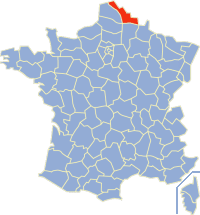Communes of the Nord department facts for kids
France is divided into many small local areas called communes. Think of a commune like a town, a village, or even a part of a big city. Each commune has its own local government, like a small council, that helps manage things for the people living there. This article is about the communes found in the Nord department, which is a region located in the very north of France. The Nord department has a lot of communes, over 650 of them!
What is a Commune?
A commune is the smallest way France divides its land for local government. It's like the basic building block of the country's administration. Every part of France belongs to a commune. Even tiny villages are communes, and so are huge cities like Paris or Lille.
Each commune has a mayor and a town council. They are elected by the people who live there. Their job is to manage local services. This includes things like schools, roads, local police, and even keeping parks clean.
Groups of Communes
Sometimes, communes work together in groups to share services. This makes things more efficient, especially for smaller communes. These groups are called "intercommunalities." In the Nord department, you'll find a few main types of these groups:
- Urban Communities (Communauté urbaine): These are groups of communes that form a large city area. They work together on big projects like public transport, water, and waste management.
- The Communauté urbaine de Lille Métropole (CUDL) was started in 1966. It includes the big city of Lille and its surrounding towns.
- The Communauté urbaine de Dunkerque Grand Littoral (CUD) was created in 1968. It covers the area around the port city of Dunkirk.
- Agglomeration Communities (Communauté d'agglomération): These groups are for medium-sized urban areas. They focus on economic development, housing, and urban planning.
- The Communauté d'agglomération de Cambrai (CAC) began in 2000.
- The Communauté d'agglomération du Douaisis (CAD) was formed in 2002.
- The Communauté d'agglomération Maubeuge Val de la Sambre (CAM) started in 2001.
- The Communauté d'agglomération de la Porte du Hainaut (CAS) was created in 2001.
- The Communauté d'agglomération de Valenciennes Métropole (CAV) began in 2001.
These groups help communes work together on common goals. This way, they can offer better services to their residents.
How Communes are Listed
Each commune in France has a special code called an INSEE code. This code is like a unique ID number for that specific commune. They also have a postal code, which is used for mail delivery.
The Nord department has 652 communes. They are usually listed in alphabetical order. Some communes are part of the larger community groups mentioned above. This is often shown with a small note next to their name, like (CUDL) for Lille Métropole.
For example, some communes you might find in the Nord department include:
- Lille: The largest city and capital of the Nord department. It's part of the Lille Métropole urban community.
- Dunkirk: A major port city on the coast, part of the Dunkerque Grand Littoral urban community.
- Valenciennes: An important city in the south-east, part of the Valenciennes Métropole agglomeration community.
- Cambrai: A historic city, part of the Cambrai agglomeration community.
- Douai: Another significant city, part of the Douaisis agglomeration community.
- Maubeuge: A city near the Belgian border, part of the Maubeuge Val de la Sambre agglomeration community.
- Saint-Amand-les-Eaux: Known for its spa, part of the Porte du Hainaut agglomeration community.
These are just a few examples of the many different communes that make up the Nord department. Each one has its own history, character, and local life.
See also
 In Spanish: Anexo:Comunas de Norte para niños
In Spanish: Anexo:Comunas de Norte para niños


